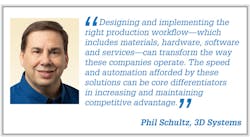At its July 8 virtual event, 3D Systems presented a series of talks on digital manufacturing solutions. In the keynote, entitled “The Essence of Agile Manufacturing,” Phil Schultz, the company’s executive vice president for operations, and Radhika Krishnan, its executive vice president and general manager of software, discussed how manufacturers can transform their workflow—an issue that has gained greater importance in the age of COVID-19.
In an interview with Machine Design, Schultz and Krishnan elaborated on those issues and how additive manufacturing has been used to accelerate product development during the pandemic, as well as how those lessons will be applied for future manufacturing challenges:
Machine Design: What is the essence of agile manufacturing?
Phil Schultz: Agile manufacturing is all about being able to move quickly and easily in response to changing market conditions and customer demand. I believe we can all agree it’s not a new concept, but its awareness has definitely been heightened in light of the global pandemic. With the spread of COVID-19, our society was forced to embrace a shift that affected how we operate and interact.
As the number of COVID-19 cases increased and healthcare workers needed increased volumes of PPE to treat patients, it was very apparent how the pandemic disrupted supply chains. Additive manufacturing (AM) rose to the forefront, demonstrating its importance in the pandemic response efforts due to its promise of no tooling requirements, near-immediate response times, and the ability to create complex and custom geometries.
One of the other striking advantages AM brings is distributed manufacturing versus a centralized supply chain fraught with the need for complex logistics and time. This is something 3D Systems was able to demonstrate during the early days of the pandemic via our on-demand manufacturing facilities. We quickly produced parts required by Italian hospitals at our facility in Italy and were able to drive them directly to the hospital. This would not have been possible with a heavily tooled, specialized, centralized production environment.
Beyond the immediate concern of getting through this situation, we also have to learn from it, and a big lesson for many is the critical role of preparation. We’re seeing many manufacturers taking a broader look at their supply chains and how they can create greater manufacturing agility using AM.
For manufacturers that wish to embrace agile manufacturing, there are three key elements to consider:
- Reduce dependencies on the existing ways of doing things, including everything from traditional production methodologies and product development cycles to supplier relationships, inventory management and in-house talent.
- As manufacturers rethink and refine their processes, they must ensure production quality, repeatability and traceability…no matter what technology they use.
- And finally, these solutions must be streamlined and powered by the right software solutions to maximize productivity and flexibility.
MD: The pandemic has forced a number of manufacturers to re-examine both internal and external operations. What have your customers told you are some of their pain points right now?
PS: Business in the “new normal” has undoubtedly changed and it’s bringing to light challenges many of our customers haven’t encountered previously, or at least not to this scale. Within the U.S., we are seeing political intervention from all levels—federal, state and counties—that are influencing disruption to supply chains.
Demand for products is changing rapidly, which is requiring companies to be more nimble. Employees are working remotely, or some have been furloughed, which means “company know-how” is reduced or dispersed. There is an increasing demand for individual solutions, with customization and personalization being common requests. And digitization and e-business are on the rise, which is increasing the demand for faster delivery across borders.
Agile manufacturing is a powerful solution for all of these challenges. Designing and implementing the right production workflow—which includes materials, hardware, software and services—can transform the way these companies operate. The speed and automation afforded by these solutions can be core differentiators in increasing and maintaining competitive advantage.
MD: How does additive manufacturing continue to evolve, and what are some of the barriers to that evolution?
Radhika Krishnan: Manufacturing is undergoing a transformation as companies introduce the power of additive manufacturing into workflows built upon traditional technologies. Manufacturers that have earned a reputation as industry leaders have already embraced how additive manufacturing (AM) can complement their traditional workflows for competitive advantage.
We’ve seen evidence in the most recent E&Y study that confirms the adoption of additive is ramping, with nearly 75% of companies embracing the technology. As a result, manufacturers are able to achieve design freedom, increase agility, scale production and improve overall total cost of operation.
Over the comparatively short history of additive manufacturing—it’s been just over 30 years since Chuck Hull invented the technology—we’ve seen 3D printing transition from being used for prototyping to being an integral part of workflows for true production applications. It’s remarkable to look at the applications AM powers, and how far we’ve come as an industry. AM is enabling creation of parts and enabling transformation in healthcare that could not be achieved with traditional technologies alone. From my perspective, the only barrier to evolution is the unwillingness to open our minds to what’s possible.
We are seeing more and more companies looking at their shop floor as a complete end-to-end workflow that includes both additive and subtractive technologies. In this environment, the importance of software increases exponentially because it is the digital thread that underlies the entire workflow. I believe we’ll see more companies bringing a level of sophistication to how software integrates into their manufacturing workflows.
We’ll see the connection of different environments—design, engineering, shop floor and quality control—into a cloud-based manufacturing process that harnesses the capabilities of individual platforms to power the entire process. In this production solution, software is the digital thread that connects each function to add control, visibility and traceability. Ultimately, this allows everyone involved to access data for analysis and simulation, helping to create and deliver the high-quality products to fuel revenue and growth.
MD: Many small to mid-sized manufacturers might benefit from an additive strategy, so what are the continuing barriers to entry?
PS: AM is a tremendously beneficial solution for many applications across the product development cycle, from prototyping to production, but it’s not right for every application. The biggest barrier to entry we see is that lack of expertise available to guide the process of selecting the right technology for the business need.
First and foremost, there needs to be an understanding of what the end-goal is and building the business case which includes the right workflow to meet that goal. When AM is determined to be the “right” technology, then you need to understand how it complements the other technologies in manufacturing workflow, and what the gaps are that need to be filled.
This process starts by looking at the application, selecting the right material, choosing the appropriate 3D printing technology and the necessary software to bring all the components together. Engaging with a partner that has the experience, expertise and know-how to guide a manufacturer through the process of consideration, planning and implementation of an additive strategy will mitigate the barriers to entry.
MD: How has additive changed the design process? And is the reverse also true—have the needs of designers changed the way 3D printers deliver solutions to those customers?
RK: Additive manufacturing enables freedom of design—allowing designers and engineers to create parts not possible with traditional technologies. With AM, customers are able to accelerate their product development cycles, often creating prototypes on the same 3D printing technology and using the same materials that will be used to produce the final part. As these prototypes are tested, iterating on the design is fast and efficient due to the sophistication of today’s CAD/CAM software.
Today, manufacturers that are recognized as innovators in their industries have embraced additive technologies as part of a hybrid environment—a combination of additive and subtractive technologies—that is built on an optimized workflow, from part design to post-processing. In embracing these advanced technologies, there is also the need to re-think the “rules” against which these workflows operate.
A shift in mindset is required for Design for Additive Manufacturing (DfAM) versus the way things were done for machining or injection molding. For those not familiar with designing a part to be produced using additive manufacturing, there is inherent risk in not optimizing the design for AM which could result in increased time-to-part and associated costs.
This is where the value comes in partnering with a company that has the experience and expertise in the industry to design the right workflow to address the application. 3D Systems believes success in manufacturing comes about from end-to-end digital solutions. We start by looking at a customer’s application needs and design the right solution to achieve the desired outcome. In fact, customer application innovation directly drives our material investigation. We continually reevaluate what materials and solutions we invest in based on how the customers are trying to use the technology.
Software is integral and the central backbone that ties together these end-to-end solutions, from digitization of a part to design and simulation, manufacturing the part with additive and subtractive technologies, and inspecting the part. Having all the right components in place help ensure a successful end-use part with the desired mechanical properties.
To illustrate this, we can look at a real-world use case. Cummins, an Indianapolis-based designer, manufacturer and distributor of engines, filtration and power generation made its mark in the racing world through the power of AM. The company’s #28 Cummins Diesel Special shocked the racing world in 1952 when it captured the pole position at the Indy 500 with the fastest lap time in history. In 2017, the #28 was invited to the Goodwood Festival of Speed in the United Kingdom to participate in the legendary Goodwood Hillclimb along with hundreds of modern and heritage cars.
While preparing #28, the Cummins engineers discovered it needed a new water pump. Due to its unique design, spare parts were not available, and they didn’t have the lead time to use traditional sand-casting methods to produce a new part. Using reverse engineering software and metal AM, Cummins’ engineers were able to reverse engineer, inspect and 3D print a water pump housing 50% faster than possible using traditional sand-casting methods.
About the Author

Bob Vavra
Editor Emeritus, Machine Design and Power & Motion
Bob Vavra is the former senior content director of Machine Design and Power & Motion.


